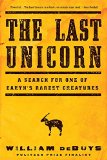Summary | Excerpt | Reviews | Beyond the Book | Readalikes | Genres & Themes | Author Bio

Critics' Opinion:
Readers' Opinion:
First Published:
Mar 2015, 368 pages
Paperback:
Oct 2015, 368 pages
 Book Reviewed by:
Book Reviewed by:
James Broderick
Buy This Book
Excerpt
The Last Unicorn
A second, even stronger purpose motivates this journey: one of the rarest creatures on the planet inhabits the forests to which we are bound. Or, rather, it has inhabited them until recently. Whether the clock of extinction now reads two minutes before midnight or two minutes after no one can say. Perhaps we'll know more when our journey is over. Perhaps, having learned to mistrust something we thought was certain, we'll know even less.
We do know, however, that the creature is extraordinary. It is as big as a carousel pony, striking in appearance, and as elusive as a ghost. It is a grazing mammal with cloven hooves and long tapered horns that curve ever so slightly backwards. According to Robichaud, who once spent two weeks closely observing one of these creatures in a crude menagerie not far from the boundary of the protected area, it possesses a disposition both singular and mysterious. The animal that Robichaud watched did not survive its captivity, but he was with it long enough to understand that it was strangely serene and unlike any other animal he had known, domestic or wild. It allowed him to touch it, to pick ticks from its ears, to tend it. It seemed Buddha-like in its calm. Compared with other animals, this one had a different sense about it, a different way of being in the world. The little that biologists like Robichaud have learned about it suggests that its habits may be unique. It does not feed in the same way as the deer and wild goats that share its dank habitat. Nor does it respond to danger as they do. It may travel along paths of its own or along no paths at all.
The creature is called saola, a word borrowed from both Lao and the closely related language of the Tai ethnic minority in the mountains of Vietnam. It is the only Lao word that has been imported into English. Sao (rhymes with now) means "post"; la is a small spinning wheel used in the Annamites: sao la are the tapered posts that support a spool for winding thread. The posts of the spinning wheel resemble the horns of the animal.
Beyond the forest villages of the Laos-Vietnam border, no one knew that saola existed until 1992, when scientists spotted strange horns on the wall of a Vietnamese hunter's shack. Suddenly the scientific world had before it proof of a large, new, living creature, previously unimagined. The news raced around the world.
Robichaud remembers exactly where he was when word of the discovery reached him. He was relaxing in a café in Vientiane, reading the Bangkok Post. A photograph caught his eye. It showed a scientist holding a pair of long, straight, sharply pointed horns. The scientist was John MacKinnon, then working for the World Wildlife Fund and a leader of the survey that had made the find. The word saola had not yet entered general use, and the unpoetic name initially given for the animal was Vu Quang ox, after the Vu Quang Nature Reserve (now a national park) in Vietnam, where the discovery was made. An inset map showed the location. It was just across the border from Laos, up from the Nakai Plateau, not far away. Robichaud, a naturalist still finding his path, was thrilled. At that moment, little else seemed more exciting or more splendid.
He had come to Southeast Asia in 1990 with the International Crane Foundation, assisting in a search for the rare sarus crane in Vietnam's Mekong River delta. After the project concluded, he had time on his hands. It struck him that Vietnam and Cambodia frequently made the news, but he never heard much about Laos — so that's where he went. He obtained a two-week visa, settled in, and soon found that he liked the people, the pace, and the feel of things. When his visa ran out, he returned to the States and began looking for a way to get back to Laos. In those days his main focus was hawks. He landed a small grant that allowed him to return in 1992, ostensibly to explore ways of conducting conservation and bird studies in Laos. When he read about the discovery of the saola and saw the proximity of its habitat to Laos, his instinct was to bend his steps in the saola's direction.
Excerpted from the book The Last Unicorn by William deBuys. Copyright © 2015 by William deBuys. Reprinted with permission of Little, Brown and Company





The Flower Sisters
by Michelle Collins Anderson
From the new Fannie Flagg of the Ozarks, a richly-woven story of family, forgiveness, and reinvention.

The House on Biscayne Bay
by Chanel Cleeton
As death stalks a gothic mansion in Miami, the lives of two women intertwine as the past and present collide.

The Funeral Cryer by Wenyan Lu
Debut novelist Wenyan Lu brings us this witty yet profound story about one woman's midlife reawakening in contemporary rural China.
Your guide toexceptional books
BookBrowse seeks out and recommends the best in contemporary fiction and nonfiction—books that not only engage and entertain but also deepen our understanding of ourselves and the world around us.